Thames Water
Thames Water Utilities Ltd, known as Thames Water, is the monopoly private utility company responsible for the public water supply and waste water treatment in large parts of Greater London, Luton, the Thames Valley, Surrey, Gloucestershire, Wiltshire, Kent, and some other areas of the United Kingdom. Thames Water is the UK's largest water and wastewater services company,[1] and supplies 2.6 billion litres (570 million imperial gallons) of drinking water per day, and treats 4.4 billion litres (970 million imperial gallons) of wastewater per day. Thames Water's 15 million customers comprise 27% of the UK population.[2][3]
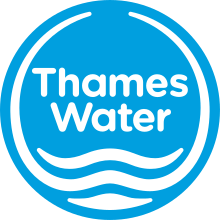 | |
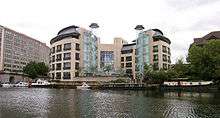 Thames Water's headquarters in Reading | |
| Private | |
| Industry | Water industry |
| Founded | 1989 |
| Headquarters | Reading, Berkshire, England |
Area served | United Kingdom, but principally South England |
Key people |
|
| Products | |
Production output |
|
| Services | |
| Revenue |
|
| |
Number of employees | 9,000 staff plus many contractors |
| Parent | Kemble Water Holdings Ltd |
| Website | www |
Thames Water is responsible for a range of water management infrastructure projects including: the Thames Water Ring Main around London; the Lee Tunnel;[4] Europe's largest wastewater treatment works [5] and the UK's first large-scale desalination plant, both at Beckton. Thames Water awarded Bazalgette Tunnel Ltd the contract to build the £4.2 billion London Tideway Tunnel [6][7] Infrastructure proposals by Thames Water include the proposed reservoir at Abingdon, Oxfordshire, which would be the largest enclosed or bunded reservoir in the UK.[8]
Thames Water is regulated under the Water Industry Act 1991 and is owned by Kemble Water Holdings Ltd, a consortium formed in late 2006 and formerly owned by Australian-based Macquarie Group's European Infrastructure Funds specifically for the purpose of purchasing Thames Water. Currently the largest shareholders are Canadian pensions group OMERS (23%),[9] BT Pension Scheme (13%),[10] the Abu Dhabi Investment Authority (9.9%),[11] the China Investment Corporation (8.7%)[12] and the Kuwait Investment Authority (8.5%).[13] The name of the company reflects its role providing water to the drainage basin of the River Thames and not the source of its water, which is taken from a range of rivers and boreholes.
In March 2017 a judge imposed a record fine of £20.3m on Thames Water after large leaks of untreated sewage, totalling 1.4bn litres, occurred over a number of years.[14]
History
Origins
Thames Water can trace its history back the building of the New River, from 1609 to 1612, which channelled fresh water from Hertfordshire to the New River Head in Islington. The business of the New River was taken over by the New River Company, officially founded by royal charter in 1619, under the leadership of Edmund Colthurst and Hugh Myddelton. Although earlier water companies existed providing fresh water to London, the New River Company is the earliest direct ancestor of Thames Water today.
During the 1850s, Dr John Snow and William Farr's identification of the 1854 Broad Street cholera outbreak provided a stimulus to the better treatment of sewage. The Thames Conservancy was established in 1857 with unified control over water supply, drainage and navigation. The Great Stink occurred in 1858, and focussed government and public opinion on cleaning up the Thames. Joseph Bazalgette's remediation of The Great Stink provided the company with much of London's present Victorian sewerage infrastructure and several listed buildings within its portfolio of sites.
In 1904 The New River Company and eight other water companies serving London were taken into public ownership under control of the newly-founded Metropolitan Water Board.
In 1973 the Metropolitan Water Board and the Thames Conservancy were taken over by the Thames Water Authority, under the terms of the Water Act 1973, along with the following water companies outside the historical boundaries of London:[15]
- Cotswold Water Board
- Croydon Corporation
- Epsom and Ewell Corporation
- The Lee Conservancy
- Mid Southern Water Company
- Middle Thames Water Board
- Oxfordshire and District Water Board
- South West Suburban Water Company
- Swindon Corporation
- Thames Valley Water Board
- Watford Corporation
- West Surrey Water Board
Privatisation and listing
In 1989, the responsibility for navigation, regulatory, river and channels management inherited from the Thames Conservancy, was transferred to the National Rivers Authority which later became part of the Environment Agency.[16] The remainder of Thames Water Authority was privatised as Thames Water Utilities Limited. The company became listed on the London Stock Exchange and was a constituent of the FTSE 100 Index.
Following international expansion, Thames Water became the world's third largest water company in 1995.[17]
Takeovers
Thames Water plc was acquired by the German utility company RWE in 2001.[18] As well as its British operations, it continued as an international water treatment consultancy and acquired further overseas operations.
On 17 October 2006, following several years of criticism about failed leakage targets in the UK, RWE announced it would sell Thames Water for £8 billion to Kemble Water Holdings Ltd, a consortium led by the Australian Macquarie Group.[19] In December 2006, the sale of Thames Water's British operation went ahead, with RWE keeping the overseas operations.[20]
Under the new ownership, the company re-focused its efforts on improving its operational performance and in 2007 announced the largest-ever capital investment programme (£1 billion p.a.) of any UK water company.[21]
In 2012 some of the company's stock was acquired by the BT Pension Scheme (13%), the Abu Dhabi Investment Authority (9.9%) and the China Investment Corporation (8.7%).| Thames Water was a Tier Three sponsor of the 2012 Summer Olympics in London.[22]
Recent years
In 2017, under the government's Open Water programme, and in common with all water and sewerage companies,[23] Thames Water must provide entirely separate retail and wholesale operations for its commercial customers, working through a central market operator.
On 14 March 2017, Macquarie Group sold its remaining stake in Thames Water's holding company to OMERS and the Kuwait Investment Authority.[24]
Finance
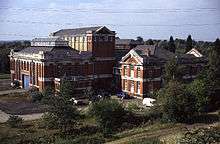
As of 2014, Thames Water provides the second cheapest residential water and sewerage charges of all the combined Water and Sewerage companies.[25]
Since 2007, it has made capital investments at least £1 billion a year in its infrastructure – the largest such annual investment within the UK water industry. In 2015–2016, this figure was £1.2 billion.[2] This level of investment has allowed the company to defer, but not avoid, substantial portions of its corporation tax liability in line with UK tax law.[26]
Performance
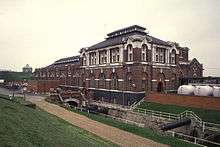
Walton-on-Thames
Every day, Thames Water abstracts / extracts, treats and supplies 2.6 billion litres (570 million imperial gallons) of potable tap water from 100 water treatment works via 288 clean water pumping stations through 31,100 km (19,300 mi) of managed water mains to 9 million customers (3.6 million properties) across London and the Thames Valley.[27] It maintains 30 raw water reservoirs and 235 underground service reservoirs.[2] As well as direct customers, Thames Water supplies bulk clean water to some inset companies. Other inset companies maintain their own independent means of supply.
Likewise, it daily removes, treats and disposes 4.4 billion litres (970 million imperial gallons) of wastewater from 15 million customers (5.1 million properties) using 2530 sewage pumping stations through 109,400 km (68,000 mi) of managed sewerage mains to 348 sewage treatment works across an area of 13,000 km2 (5,000 sq mi) of South England.[27] On 1 October 2011, it adopted 40,000 km (25,000 mi) - an additional 60% - of private sewers and lateral drains to add to its then stock of 68,000 km (42,000 mi) giving a new network of 108,000 km (67,000 mi). By 2015, this figure had grown to 109,400 km (68,000 mi) managed sewerage mains. Before 1 October 2016, it is obliged to adopt 5,000+ private sewage pumping stations to add to its current stock of 2530 managed sewage pumping stations [2][28] Again, Thames Water treats and disposes bulk sewage on behalf of some inset companies.
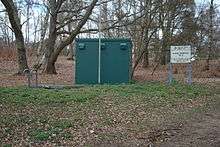
Thames Water produces biosolid fertiliser as a by-product from the waste treatment, and supplies this to local farms.
It also recovers phosphates – an increasingly important source of a dwindling naturally occurring mineral.
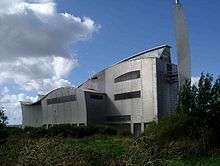
As of 2013, it recovered approximately 18 MW (156 GWh per year), or 12.5% of its total energy requirements from renewable electricity generated from biogas collected from the sewage. Further biogas capacity, the burning of 'fatbergs' removed from London's sewers and substantial solar farms have enabled the company to announce a 2015–16 target of generating 36 MW (318 GWh per annum) or 20% of its total energy requirements from renewable sources,[2][29][30][31] a 2020 target of self-generating 33% of electricity needs,[2] and a commitment to 100% renewable energy eventually.[2]
Health and safety
In December 2014 Thames Water pleaded guilty to a charge under the Health and Safety at Work etc. Act 1974 after the death at work of one of its workers. It was fined £300,000 with £61,000 prosecution costs. The incident occurred at its Coppermill Water Treatment Works in Walthamstow, London E17 in April 2010 when an excavator reversed over and killed the worker in a slow sand filter. The prosecution followed an investigation by the Health and Safety Executive.[32]
Leakage
2001–06 (RWE's ownership)
Thames Water was repeatedly criticised for the amount of water that leaked from its pipes by the industry regulator Ofwat and was fined for this.
In May 2006 the leakage was nearly 900 million litres (200 million imperial gallons) per day and in June that year Thames Water missed its target for leakage reduction for the third year in a row.[33] The Consumer Council for Water, a customers' group, accused Thames Water for continuing to miss its targets for the past five years. In July 2006, instead of a fine which would have gone "to the exchequer", the company was required to spend an extra £150 million on repairs.[34]
Since 2007 (Kemble's ownership)
Thames Water has hit its Ofwat-agreed annual leakage-reduction target for the past ten years running (2006 to 2016).[2]
In 2006–07, the company stated that it had reduced its daily loss through leaks by 120 million litres (26 million imperial gallons) to an average of 695 million litres (153 million imperial gallons) per day.[35] For 2009–10 the Ofwat-reported daily leakage was 668.9 million litres (147.1 million imperial gallons).[36] In its price control determination for the period 2010 to 2015, Ofwat did not allow the funds needed to finance a significant further reduction in leakage and used the assumption that daily leakage would be 674 million litres (148 million imperial gallons) in 2010–11 and 673 million litres (148 million imperial gallons) from 2011 to 2012.[37] In 2011–12, actual daily leakage was 637×106 l (140×106 imp gal); in 2012–13, 646×106 l (142×106 imp gal); in 2013–14, 644×106 l (142×106 imp gal); in 2014–2015, 654×106 l (144×106 imp gal); in 2015–2016, 642×106 l (141×106 imp gal).[2]
The company has achieved these reductions by:
- better pressure management of known problem sectors of its older water network
- replacing 2,736 km (1,700 mi) of worn-out Victorian pipes, mainly under London
The recent successes in meeting leakage targets have mitigated the earlier failures to meet targets. As a result, and in spite of a larger distribution network, Thames Water now leaks slightly less water than at privatisation in 1989, having reduced leakage from its 31,100 km (19,300 mi) network of water pipes by more than a third since its 2004 peak to its current lowest-ever level.[38] As of 2013 and with an older network profile, Thames Water leaked 25.8%[39] of supply, slightly less than Severn Trent at 27%.[40] As of 2015 Thames Water leaked 25.1% of supply.[41]
In June 2018 regulators made Thames Water pay £65 million to customers among other problems because they failed to fix leaks.[42]
Pollution
In the period 2005–13 Thames Water was the most heavily fined water company in the UK for pollution incidents, paying £842,500 for 87 events. In 2016, it paid the largest fine for a single pollution incident of £1 million.[43] In March 2017, Thames Water was fined a record £20.3 million after it pumped nearly 1.5 billion litres of untreated sewage into the River Thames.[14] The company also admitted other water pollution and offences in Buckinghamshire and Oxfordshire.[44] In awarding the fine, Judge Francis Sheridan noted the company's "continual failure to report incidents" and "history of non-compliance", saying: "This is a shocking and disgraceful state of affairs. It should not be cheaper to offend than to take appropriate precautions. I have to make the fine sufficiently large that [Thames Water] get the message", adding that, "One has to get the message across to the shareholders that the environment is to be treasured and protected, and not poisoned.".[14] What was "shocking and disgraceful" was not just the scale of the pollution, but that it was intentional. Sheridan added "the constant use of flow clipping to protect the treatment process, so that, despite the regular and prolonged discharge of untreated sewage to the River Thames via the storm outfalls, all samples taken at the final effluent outfall complied with the permit. This was deliberately done and gave a false impression of the sewage treatment works’ performance and undermined the operator’s self-monitoring process."[45]
Conversely, in 2014, Thames Water admitted that it had accidentally over-reported the number of properties at high risk of sewage flooding between 2005 and 2010. It agreed to a compensation package for customers of £86 million.[46]
Other incidents

In September 2007, 5 km (3.1 mi) of the River Wandle, Greater London was polluted. In January 2009, Thames Water pleaded guilty at Sutton Magistrates Court, and was subsequently fined £125,000 at Croydon Crown Court and ordered to pay £21,335 in clean-up and investigation costs.[47] In February 2010, on appeal, the fine was found to be "manifestly excessive" and was reduced to £50,000.[48]
On 5–8 June 2011, more than 230,000 cubic metres (8.1 million cubic feet), or 230,000 tonnes, of sewage were released from Mogden Sewage Treatment works, killing 26,000 fish.[49]
Between 14 and 16 August 2011, Thames Water polluted the Faringdon Stream, in Faringdon, Oxfordshire. The company was fined £10,000 and ordered to pay costs of £4,488 [50]
On 29 October 2011, Thames Water released thousands of tonnes of raw sewage into the River Crane in Greater London, killing thousands of fish, when a six-tonne valve jammed during routine maintenance. Despite tankering and alternative routing, the volume of sewage from Heathrow overwhelmed the operations. Thames Anglers Conservancy's Robin Vernon said: “It will take a decade to repair all the damage done by the sewage spill. Everything in there is just dead now.”[51] In 2013, fungus and slime in the River Crane was attributed to runoff of de-icer from Heathrow getting into the river [52] In 2014, Thames Water blamed recent pollution on fat poured down drains by local customers.[53]
On 9 December 2011, Thames Water was fined £60,000 after releasing sewage sludge into the Foudry Brook killing up to 20,000 fish in a three-mile stretch from Silchester, Hampshire.[54]
In September 2012, clogged-up pumps caused sewage to be released into the Chase Brook, near Newbury. A £250,000 fine imposed in August 2014 was adjudged "lenient" on appeal in 2015. The pumps were replaced by improved pumps.[55]
In January 2016, Thames Water was fined a record £1m for polluting the Grand Union Canal in Hertfordshire between July 2012 and April 2013. In addition, it was required to pay costs of £18,000 and a victim surcharge of £120. In its defence, Thames Water said it had spent £30,000 replacing equipment at Tring.[43]
On Christmas Day 2016, the Thames Water Hampton pump failed and as a consequence, thousands of Londoners in the TW and W postcode areas were left without water.
In December 2018, Thames Water was fined £2m for polluting two brooks near Milton-under-Wychwood in Oxfordshire. On 8 and 9 August 2015, raw sewage was discharged into the water, killing 150 fish. It was also forced to pay legal costs of £79,991.57.[56]
In July 2019, Thames Water was fined £607,000 for polluting the Maidenhead Ditch and the River Cut in Berkshire. In June 2014, raw sewage and treated sewage was discharged into the Maidenhead Ditch. Thames Water has a licence to discharge sewage into the watercourse in storm conditions. However, in June 2014 there were no extreme weather events which would allow the company to discharge untreated sewage. The company also did not meet the conditions which would allow it to discharge treated sewage. Another incident of sewage discharge occurred on 7 August 2014. The company was also ordered to pay costs of £100,000.[57]
Local planning
In 2011, the company found itself involved in a controversial redevelopment plan for the Bath Road Reservoir in its home town of Reading. An appeal against Reading Borough Council's rejection of the plan was dismissed by the planning inspector in January 2011.[58] Full planning permission was subsequently granted on 10 December 2012.[59]
Flooding
The exceptional rain and weather conditions of 2013–14 caused swollen rivers and several low-lying Thames Water treatment works to be submerged under flood water.
In February 2014, the River Ash caused flooding in homes in Staines-upon-Thames. This flooding was exacerbated by a two-day delay by Surrey County Council's 'Gold Control' flood control group in ordering Thames Water to close a sluice gate on a Thames Water aqueduct. Thames Water considered it had been following an existing protocol agreed with Surrey County Council and the Environment Agency.[60]
Sheep
Thames Water maintains commercial flocks of sheep on the borders of several of its reservoirs, which are used as the cheapest way to stop large plants growing and damaging the banks.[61]
Thames Tideway scheme
Over centuries of London's growth from medieval times to the Victorian age, the natural tributary system of the Thames Tideway was converted first into public open sewers and then closed over into covered sewers which emptied directly into the River Thames.[62] Joseph Bazalgette's remediation of the ensuing 1850s Great Stink renewed much of London's sewerage mains infrastructure during the period 1859 to 1865. However, the new design was not intended to cope with the doubling of London's population over the following 150 years. The concreting of huge amounts of London's green spaces causes substantial rainwater run-off into the drainage and sewerage systems which had been expected to soak into the ground. As a result, even small amounts of rainfall in certain circumstances can cause London's outdated Victorian sewerage system to fail over, and release untreated sewage mixed with rainwater directly into the Thames Tideway.
Each year, on average, there are 50–60 such incidents and a total of 39 million cubic metres (1.4 billion cubic feet), or 39 million tonnes, is released.[63] In 2013–14, exceptional weather conditions and flooding caused a total release of 55 million cubic metres (1.9 billion cubic feet), or 55 million tonnes.[64] The released effluent follows the ebb and flow of the tidal Thames, and can take up to 3 days to exit the Tideway into the Estuary. For this reason, Thames Water advises against swimming in the Thames Tideway[65] and, by extension, walking in the tidal strand area. Despite this pollution, large marine mammals are increasingly found in the Thames Tideway and Estuary, indicating some level of year-on-year improvement [66][67][68]
To mitigate and resolve the above problems, the Thames Tideway Scheme proposed a three-stage series of improvements. The first two stages of the improvements were upgrades to 5 sewage treatment works and construction of the 6.9 km (4.3 mi) Lee Tunnel, formally opened on 28 January 2016.[4] Together, these are expected to result in an annual discharge reduction of 40%. This is equivalent to a reduction of 16 million cubic metres (570 million cubic feet) or 16 million tonnes per year, down to about 23 million cubic metres (810 million cubic feet) or 23 million tonnes of effluent per year.[69] The third stage is the 25 km (16 mi) Thames Tideway Tunnel, which was proposed by the Thames Tideway Strategic Study, including Thames Water, as an effective solution to deal with most of the remaining problem. On 12 September 2014, planning consent was formally approved by the UK Government.[70] On 24 August 2015, the building contracts were awarded for the western section (Ealing to Hammersmith: £416 million, to BAM Nuttall, Morgan Sindall and Balfour Beatty), the central section (Hammersmith to Tower Bridge: £746 million, to Ferrovial Agroman and Laing O'Rourke) and the eastern section (Tower Bridge to Stratford and Greenwich: £605 million, to Costain, Vinci Construction Grands Projets and Bachy Soletanche).[71] On 3 November 2015, Bazalgette Tunnel Ltd received its operating licence from OFWAT, ensuring the start of the project.[7]
The necessity for action has added urgency because of imminent water quality fines of up to £1bn by the European Commission on the UK Government.[72][73]
References
- "Thames Water AMP6 alliance already working on delivery plans". Waterbriefing.org. London. 11 December 2013. Retrieved 28 May 2014.
- "Annual Performance Report 2015–2016" (PDF). Thames Water. June 2016. Retrieved 18 June 2016.
- "Facts and Figures". Thames Water. Retrieved 31 May 2014.
- "Mayor of London opens Lee Tunnel". Water and Wastewater Treatment. 29 January 2016. Retrieved 4 February 2016.
- "Bye-bye big stink" (PDF). Beckton in Focus, The Newham Mag, London Borough of Newham. April 2010. Retrieved 9 March 2013.
- "Thames Tideway Tunnel". London Councils website. Retrieved 9 March 2013.
- "Green light for £4.2bn London 'super sewer'". Thames Tideway Forum. 3 November 2015. Archived from the original on 17 November 2015. Retrieved 15 November 2015.
- "Need for reservoir 'not proven'". BBC News. 5 January 2007. Retrieved 12 February 2011.
- https://uk.reuters.com/article/uk-thameswater-borealis/borealis-buys-additional-5-5-percent-in-thames-water-from-amp-capital-idUKKBN1AB0SC
- Harrington, Ben (30 May 2012). "BT Pension Scheme seals deal for 13pc stake in Thames Water". London: The Telegraph. Retrieved 23 March 2013.
- "Macquarie sells 9.9% stake in Thames Water to Abu Dhabi Investment Authority". Waterbriefing.org. 13 December 2011. Retrieved 23 March 2013.
- "China wealth fund buys nearly 9% of Thames Water". BBC News. 20 January 2012. Retrieved 9 March 2013.
- https://www.ft.com/content/63ae6f88-08a5-11e7-97d1-5e720a26771b
- Carrington, Damian (22 March 2017). "Thames Water hit with record £20m fine for huge sewage leaks". The Guardian. London. Retrieved 22 March 2017.
- The Thames Water Authority Constitution Order 1973
- Larry Elliott and Jill Treanor (22 November 2000). "A whole world sold on sell-offs". London: The Guardian. Retrieved 9 March 2013.
- "1995–2001 - International expansion". Thames Water. Retrieved 13 June 2014.
- Hope, Christopher (19 February 2002). "Germany's RWE in frame for Thames Water owner Takeover bid for power giant sparks surge in share price". The Herald, Scotland. Retrieved 9 March 2013.
- "Thames Water to be sold for £8bn". BBC News. 16 October 2006. Retrieved 12 August 2013.
- Edmund Conway and Ben Harrington (17 October 2006). "Macquarie buys Thames Water in £8bn deal". London: The Telegraph. Retrieved 9 March 2013.
- "Thames Water in £1bn leaks plan". BBC News. 29 June 2007. Retrieved 9 March 2013.
- Mackay, Duncan (31 May 2011). "London 2012 sign up Thames Water as sponsor". insidethegames.biz. Retrieved 9 March 2013.
- "Open Water - About Us". Open Water programme. Retrieved 1 June 2014.
- Ambrose, Jillian (14 March 2017). "Macquarie sells off final stake in Thames Water". The Telegraph. Retrieved 15 March 2017.
- "Average household bills information: 2013–14". www.ofwat.gov.uk. Ofwat - UK Government regulator. Retrieved 28 May 2014.
- Rankin, Jennifer (10 June 2013). "Thames Water pays no corporation tax on £1.8bn turnover". The Guardian. London.
- "GIS Foundation at Thames Water". Barnsnape Consulting. 2008. Retrieved 2 September 2012.
- "Thames Water Utilities Limited: Annual Report & Financial Statements for the Period ended 31 March 2012" (PDF). Thames Water. 26 June 2012. Retrieved 2 June 2013.
- "On board London's giant floating solar farm". BBC News. 22 March 2016. Retrieved 22 March 2016.
- "Thames Water and 2OC in £200m deal to turn 'fatbergs' into energy". waterbriefing.org. 8 April 2013. Retrieved 2 June 2013.
- "Thames Water to generate 20 per cent of energy needs with sewage scheme". utilityweek.co.uk. 5 March 2013. Retrieved 2 June 2013.
- "Utility company sentenced for worker death". Health and Safety Executive Media Centre. 8 December 2014. Retrieved 4 January 2015.
- "Thames Water misses leak target". BBC News. 22 June 2006. Retrieved 9 March 2013.
- "Thames Water escapes leakage fine". BBC News. 4 July 2006. Retrieved 9 March 2013.
- "Thames Water hails leak progress". BBC News. 26 November 2007. Retrieved 12 February 2011.
- "Service and delivery – performance of the water companies in England and Wales 2009–10 - Supporting information" (PDF). Ofwat. 27 October 2010. p. 46. Retrieved 12 February 2011.
- "Future water and sewerage charges 2010–15: Final determinations" (PDF). Ofwat. 26 November 2010. pp. 50–52. Retrieved 12 February 2011.
- "Thames Water leakage - explanatory graphs" (PDF). Ofwat. Retrieved 9 March 2013.
- 2012/13 figures: 646×106 l (142×106 imp gal) daily leakage; 2.5×109 l (550×106 imp gal) daily supply
- Pearce, Fred (8 May 2012). "The water industry is burying a leaking pipes scandal". The Guardian. London. Retrieved 9 March 2013.
- 2014–2015 figures: 654×106 l (144×106 imp gal) daily leakage; 2.6×106 l (0.57×106 imp gal) daily supply
- Thames Water to pay back £65m to customers as part of penalty package The Guardian
- "Record £1m fine for Thames Water after sewage leaked was into canal". Evening Standard newspaper. 5 January 2016. Retrieved 5 January 2016.
- "Thames Water fined £20m for sewage spill". BBC News. 22 March 2017.
- Prescott, Matt (June 2017). "Water Industry Risks Briefing 2017" (PDF). Environmental Rating Agency. Retrieved 16 August 2019.
- "Thames Water to pay £86m package after mis-reporting data". BBC News. 5 June 2014. Retrieved 5 June 2014.
- Britain’s largest water company prosecuted for 5km river pollution Archived 5 June 2011 at the Wayback Machine, Environment Agency, February 2009; retrieved on 5 February 2009.
- "Thames Water fine for toxic spill in River Wandle cut". BBC News. 15 February 2010. Retrieved 9 March 2013.
- "Thousands of River Thames fish killed by storm sewage". BBC News. 8 June 2011. Retrieved 2 September 2012.
- "Thames Water ordered to pay £14K+ for stream pollution". waterbriefing.org. 25 February 2013. Retrieved 9 March 2013.
- Bishop, Rachel (1 November 2011). "River Crane 'destroyed' by sewage spill". Richmond and Twickenham Times. Retrieved 2 September 2012.
- Cumber, Robert (21 March 2013). "Heathrow blamed for slime pollution in river". Hounslow Chronicle. Retrieved 1 August 2015.
- Cumber, Robert (8 July 2014). "Latest pollution to River Crane blamed on fat blockage". GetWestLondon. Retrieved 15 July 2014.
- "Thames Water forced to pay out £60,000 over sewage spill". Reading Post. 9 December 2011. Retrieved 2 September 2012.
- "Thames Water brook sewage £250,000 fine deemed 'lenient'". BBC News. 3 June 2015. Retrieved 3 June 2015.
- "Thames Water fined £2m for raw sewage pollution". BBC News. 21 December 2018. Retrieved 21 December 2018.
- "Thames Water fined for polluting Berkshire waterway". Gov.uk. 10 July 2019. Retrieved 10 July 2019.
- "Bath Road reservoir homes appeal rejected after inquiry". BBC News. 15 January 2011. Retrieved 9 May 2011.
- "Consultation on Construction of Homes at Bath Road Reservoir Site". Reading Borough Council. 7 February 2013. Retrieved 23 March 2013.
- "Staines residents seek flooding compensation". BBC News. 13 November 2014. Retrieved 14 November 2014.
- "The real-life reservoir dogs (press release)". PR Newswire. Thames Water. Retrieved 4 December 2016.
- Dangerfield, Andy (4 October 2015). "The lost rivers that lie beneath London". BBC News. Retrieved 4 October 2015.
- "Thames Tunnel Consultation". Thames Tunnel partnership. Archived from the original on 30 July 2013. Retrieved 9 March 2013.
- "Tideway Times, March 2014" (PDF). Thames Water. Retrieved 6 June 2014.
- "David Walliams given River Thames sewage warning". BBC News. 10 September 2011. Retrieved 1 June 2014.
- Morelle, Rebecca (20 August 2015). "Marine mammals thriving in Thames". BBC News. Retrieved 21 August 2015.
- Hardach, Sophie (12 November 2015). "How the River Thames was brought back from the dead". BBC News. Retrieved 14 November 2015.
- "Stranded River Thames whale 'evoked huge public response'". BBC News. 9 January 2016. Retrieved 9 January 2016.
- Cross, Luke (13 November 2012). "Open Doors: Lee Tunnel lifts lid on 'exciting' world of construction". Construction News. Retrieved 9 March 2013.
- "London's 'super sewer' gets the go ahead". BBC News. 12 September 2014. Retrieved 21 September 2014.
- Farrell, Sean (24 August 2015). "London super sewer to cost less than expected, says Ofwat". theguardian.com. Retrieved 25 August 2015.
- "UK faces fine on EU water breach". BBC News. 18 October 2012. Retrieved 8 June 2013.
- Harvey, Fiona (26 January 2012). "Thames super-sewer a 'necessity' to prevent EU fines". London: The Guardian. Retrieved 8 June 2013.